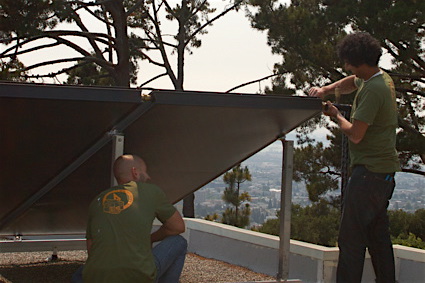Bad for the Lab, Good for the Country
 Staff at Building Solutions, a home performance
Staff at Building Solutions, a home performance
company, install PV on a roof in Oakland. Next year, the renewable
and energy efficiency business will be even better.
Credit: Kate KenkeDr. Steven Chu, Noble-prize-winning physicist, and director of Lawrence Berkeley National Laboratory, was named as President-elect Barack Obama’s nominee for Secretary of Energy. Home Energy is a nonprofit magazine, but our offices are at Lawrence Berkeley Lab and the magazine was founded by Alan Meier, a lab scientist. People around here are saddened by the loss of Dr. Chu as director of the lab, but extremely excited about his nomination as Secretary of Energy. Dr. Chu believes in science and the important place of technology in helping us meet our energy goals and fight global warming—think cellulosic bio-fuels, nanotechnology, and yet undreamed of solutions to the present energy and environmental crisis.
Weatherization Works!
Word in energy efficiency circles is that the funding for Department of Energy (DOE’s) Weatherization Program will increase several-fold with President Obama’s proposed economic stimulus package. The Weatherization Program is managed state by state from money provided by DOE, and the funds pay to retrofit the homes of low-income families. Homes become healthier to live in, more energy efficient, and more comfortable for the occupants. For every one dollar the Weatherization Program spends, almost two dollars in energy savings results. Hundreds of thousands of homes have been retrofit so far, leaving about 99.5% of existing homes. Talk about green jobs potential! Many nonprofit and for profit organizations do weatherization work, and, basically, you retrofit the home of a low-income family the same way you retrofit a mansion. Lots more skilled people will be needed to do the work, and the jobs will provide a good income, benefits, and the possibility of future advancement. Community colleges, unions, professional training organizations, online trainers, and other players are gearing up to train the new green workforce.
How Many Btu Do You Do?
